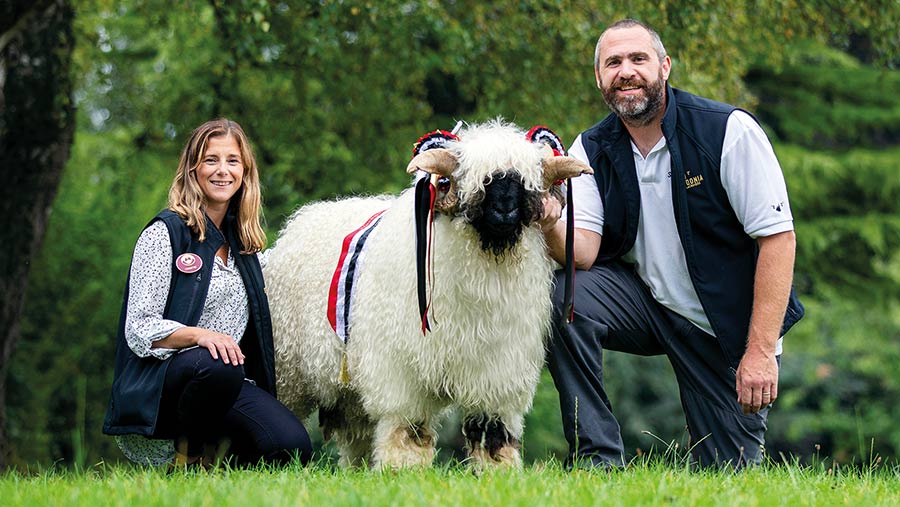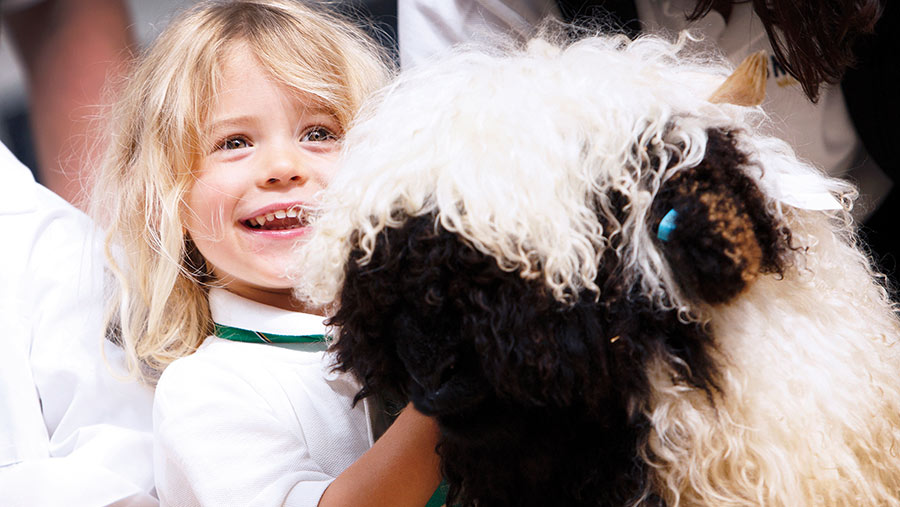Top breeders give advice on buying Valais Blacknose sheep
 Kerrie and Gerallt Jones have been very successful in the showing with their Valais Blacknose sheep © MacGregor Photograhy
Kerrie and Gerallt Jones have been very successful in the showing with their Valais Blacknose sheep © MacGregor Photograhy Kerry Jones recalls being laughed out of the ring in the early days of exhibiting her Valais Blacknose sheep at agricultural shows, but the breed is the fastest-growing in the UK, with values soaring.
However, as she is quick to point out: “It is not about the money for us; it is about the passion for the breed and breeding in the traditional Swiss way.”
Such is the level of interest that some breeders even insist potential buyers pay a non-refundable deposit, which can be as much as 25% of the animal’s value, to secure stock.
See also: Farmers Weekly Awards: 2021 Sheep Farmer of the Year finalists
Mrs Jones and her husband, Gerallt, don’t follow that approach, welcoming buyers to the farm and even insisting that a purchase is never made on the strength of a photograph alone.
Establishment
The Joneses first established the Snowdonia Valais Blacknose flock as an interest for their two youngest sons.
Mr Jones’ father, Alfie, runs a commercial flock of Lleyns, Texel-crosses, Balwens and Welsh Mountains on his farm close to their home in Caernarfon, and the boys, Alfie and Luca, enjoyed spending time with the sheep.
“The boys are obsessed with going to Granddad’s farm, but his sheep are quite lively. There can be a few bumps and knocks when the boys are helping, so we looked at buying some more placid breeds for them,” says Mrs Jones.

The flock was started for the Joneses’ two boys, Luca (pictured) and Alfie © MacGregor Photograhy
The family bought Grey Face Dartmoor ewes, soon followed by the first Valais Blacknose. A £700 ram named Eddie joined their small flock at Pant Gwyn, Waunfawr, with the purpose of breeding quality show animals.
Their target was to get to 20 breeding ewes, but next year they will be up to 30 – they currently have just under 40 animals in the flock in total.
“We can’t go much bigger. We joke with Gerallt’s father that he will have to reduce his commercial flock so we have more space,” says Mrs Jones.
Neither are full-time farmers – Mr Jones works for a hydroelectric company and Mrs Jones works in marketing and communications – but, as their flock has grown, more of their spare time is taken up with managing it.
Valais Blacknose society
The Valais Blacknose Society in the UK has 550 members.
When the flock was first set up in 2015, there were 151 registered sheep. In 2020, there were 1,713.
The numbers look set to increase again – up to the end of the first eight months of 2021 there were 1,483 registered sheep.
Breeding and bloodlines
Tupping starts at the beginning of October to allow for lambing in late March, when grass availability starts to pick up in Snowdonia.
All service is natural, as the Joneses have invested well in rams from different bloodlines.
That means planning ahead and buying rams with different bloodlines to alternate on the offspring.
Quality is always the main priority. “Gerallt has a good eye for stock and tends to know what would be graded well by the Swiss judges,” says Mrs Jones.
Breed standards are quite specific – black patches on both knees and hocks, four black boots, black faces and ears, no black on the body, and females must have a black spot on their bottoms, but not the rams.
The breed standards were set up in Switzerland and the UK society follows the same principles.
“Breeding the perfect animal for showing is not an easy task. Overall appearance, inclusive of markings, needs to be correct, as should conformation and wool quality.”
Mismarked ram lambs are castrated, but the Joneses have only had two that have fallen short.
Despite what can be a harsh winter in Snowdonia, the Joneses’ flock is happiest outdoors, so the sheep are only housed three weeks before lambing and for a few weeks after shearing in February.
“Most breeders seem to house for the winter, but ours like being outside. They have access to field shelters and sheds, but they don’t really use them,” says Mrs Jones.
Tips for establishing a Valais Blacknose flock
- With high demand resulting in little price difference between good- and poorer-quality animals, Kerry Jones urges people to do their research, speak to people who have knowledge of the breed and invest wisely
- When visiting a seller, don’t feel obliged to buy an animal if it is not the one you want
- Have a vision for the purpose of your flock – is it to show, to export or for the fleeces? Be clear in your own goals. It may be that you want the animals as a hobby and, if so, a castrated male could serve that purpose without a big financial outlay
- Don’t buy if the animal doesn’t have a pedigree certificate – make sure you have all the paperwork
Nutrition and shearing
Ewes are fed hay and concentrate at housing and turned out to grass swiftly after lambing.
The Valais Blacknose is an easy-lambing breed, so lambing is mostly trouble-free.
Lambs are weaned at four months, and most do so naturally.
The sheep, which have distinctive long fleeces, are shorn twice a year – in February and at the end of September, to fit in with the showing season. Fleeces are sold for £25 each if they come straight off the sheep, or £40 if the fleece is from a show animal, as this will have been washed.
They are sold as props for baby photoshoots or to spinners and felters, but the Joneses are also considering their own line of products to market in the future.
Showring success
Despite being new to pedigree sheep breeding, the Jones family have had great success at sales and shows.
One of their tups, Snowdonia Goliath, sold for 14,000gns at the Blacknose Beauties show and sale at Carlisle in August 2021, a UK record for the breed. Before that, in 2019, the family also set a record when they sold a shearling ram for 11,000gns.
Although the pandemic has meant that shows have been few and far between, the family won the reserve supreme champion, female champion and reserve male champion awards at Cheshire Show this year.
They are delighted the Valais Blacknose now has its own class at the Royal Welsh Show, although the pandemic has prevented the first competitions from being run.
“We had to work for years to get a class, by showing support for the ‘other continental breeds’ class. With the support of fellow breeders and the Valais Blacknose Society, it is a massive achievement that we have now done that,’’ says Mrs Jones.
